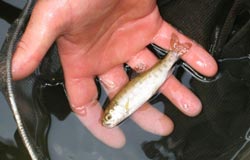A creek runs through it
October 30, 2009
Bringing a creek back to life isn’t a job – it’s a commitment for all seasons.
And for the biologists, environmentalists and volunteers who’ve made it their mission to restore Topanga Creek, removing 26,000 tons of concrete and debris last year was just the beginning.
This fall, they’ve moved into planting mode, laying the groundwork—literally—for a rebirth of not just a creek but of an entire ecosystem.
The oaks, sycamores, cottonwoods and other California native plants are still going into the ground, but Rosi Dagit, the driving force behind the project, has seen enough to declare the process a success.“Beyond our wildest dreams, it worked,” says Dagit, senior conservation biologist with the Resource Conservation District of the Santa Monica Mountains. Dagit has spearheaded the creek restoration effort with a huge and varied array of supporting players that includes the Mountains Restoration Trust, the Temescal Canyon Association, TreePeople, the California Conservation Corps and a Sierra Club trail crew.
“It’s huge,” says Jo Kitz, co-executive director of the nonprofit Mountains Restoration Trust, praising Dagit’s tenacity. “I don’t know how many agencies she had to go through to get where we’ve gotten. Once it’s done, it’s just going be one of the brightest spots in the mountains.”
Although the project has been years in the making, progress has been dramatic lately. The first big test of the restoration effort came last winter, with the downpours of December.
Would Topanga Creek return to its natural flow, now that a 1,000-foot-long mound of debris had been leveled? Would the creek once again become a birth canal of sorts for endangered steelhead trout that once flourished in its waters?
Dagit and her team crossed their fingers, jumped in their cars and headed to the creek to see whether their carefully crafted plans would unfold in the natural world as they’d envisioned. They were awestruck.
“It was the coolest thing ever,” says Dagit. “We couldn’t cross the creek because the water level was so high. I was a little weepy.”
The massive project had, in fact, worked to send water racing again through a stretch of the creek that had been rendered largely dry by the concrete berm, originally built four decades ago to protect homes from canyon flood waters. Over the years, residents just kept piling it higher and higher. Tons of backed-up sediments from the berm had literally driven the stream underground. Over the course of the next few years, winter rains will continue the clean-up process, washing sediment out to the shore, Dagit says.
And the steelhead trout, which live in both fresh and salt water, will have a straight shot from creek to ocean—and a swimming chance to repopulate in far greater numbers. What’s more, new habitat has been created for other at-risk creatures, including pond turtles, two types of garter snakes, the California newt and an assortment of frogs.
In all, during three months last fall, 26,000 tons of dirt and debris were hauled away—all of it recycled except for 94 truckloads of hazardous soil. Native plants and trees were protected, and native lupines were planted. The total cost was about $3 million in government grants, including $450,000 from Supervisor Zev Yaroslavsky’s Third District funds.
Over the past year, monthly workdays have drawn volunteers to plant, water and weed. The Conservation Corps recently swooped in to pick up 30 tons of left-behind concrete and 10 tons of asphalt. A Sierra Club trail crew has chopped away invasive non-native plants like arundo.
“It’s an extremely big deal,” Ron Webster, leader of the Sierra Club’s Santa Monica Mountains trail crew, says of the project. “The creek is an incredibly important resource. It’s so rare to have a year-round creek running through the mountains and to the ocean.”
With the creek finally reconnected, the biologists are turning their attention not only to planting but to the progress of the steelhead trout.
Late last year, Dagit and her colleagues tagged 75 to 100 of the endangered fish to track their movements. An antennae was placed in the stream to register each time one of the tagged steelhead passed by on its way to or from Santa Monica Bay. (A warning to would-be poachers: there’s a $25,000 fine for removing steelhead from the creek.) This November, Dagit and her 10-person team are going to hand-capture fish and compare scale samples with those taken last year — an unprecedented way to document the age and growth rate of steelhead in this location.
Eventually, the heavy work of planting will be completed and the focus will shift to another huge undertaking: the clean-up of Topanga Lagoon. But there are moments, as the seasons march by, when Dagit can’t resist stopping to savor the satisfaction of all that’s already been accomplished.
“I actually can’t believe we really did this,” she says. “I’m still pinching myself.”





















 405 bridge work causes a stink
405 bridge work causes a stink
